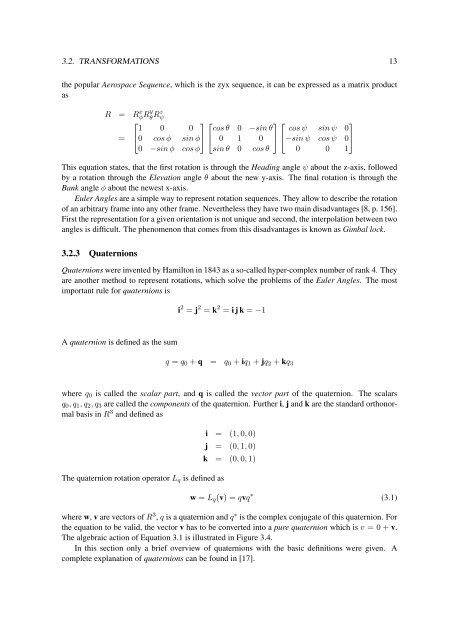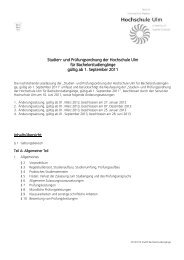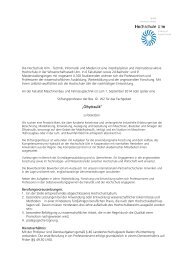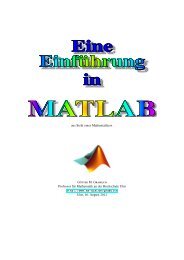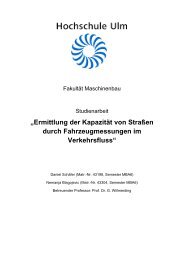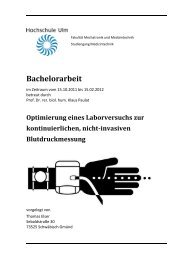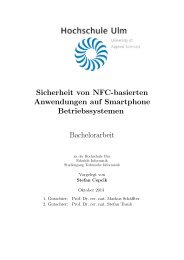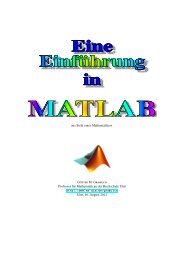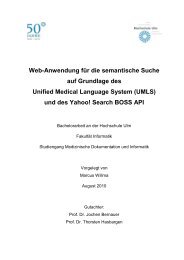PDF 1.938kB
PDF 1.938kB
PDF 1.938kB
You also want an ePaper? Increase the reach of your titles
YUMPU automatically turns print PDFs into web optimized ePapers that Google loves.
3.2. TRANSFORMATIONS 13<br />
the popular Aerospace Sequence, which is the zyx sequence, it can be expressed as a matrix product<br />
as<br />
R = Rφ x Ry θ Rz ψ<br />
⎡<br />
⎤ ⎡<br />
⎤ ⎡<br />
⎤<br />
1 0 0 cos θ 0 −sin θ cos ψ sin ψ 0<br />
= ⎣0 cos φ sin φ⎦<br />
⎣ 0 1 0 ⎦ ⎣−sin ψ cos ψ 0⎦<br />
0 −sin φ cos φ sin θ 0 cos θ 0 0 1<br />
This equation states, that the first rotation is through the Heading angle ψ about the z-axis, followed<br />
by a rotation through the Elevation angle θ about the new y-axis. The final rotation is through the<br />
Bank angle φ about the newest x-axis.<br />
Euler Angles are a simple way to represent rotation sequences. They allow to describe the rotation<br />
of an arbitrary frame into any other frame. Nevertheless they have two main disadvantages [8, p. 156].<br />
First the representation for a given orientation is not unique and second, the interpolation between two<br />
angles is difficult. The phenomenon that comes from this disadvantages is known as Gimbal lock.<br />
3.2.3 Quaternions<br />
Quaternions were invented by Hamilton in 1843 as a so-called hyper-complex number of rank 4. They<br />
are another method to represent rotations, which solve the problems of the Euler Angles. The most<br />
important rule for quaternions is<br />
i 2 = j 2 = k 2 = i j k = −1<br />
A quaternion is defined as the sum<br />
q = q 0 + q = q 0 + iq 1 + jq 2 + kq 3<br />
where q 0 is called the scalar part, and q is called the vector part of the quaternion. The scalars<br />
q 0 , q 1 , q 2 , q 3 are called the components of the quaternion. Further i, j and k are the standard orthonormal<br />
basis in R 3 and defined as<br />
The quaternion rotation operator L q is defined as<br />
i = (1, 0, 0)<br />
j = (0, 1, 0)<br />
k = (0, 0, 1)<br />
w = L q (v) = qvq ∗ (3.1)<br />
where w, v are vectors of R 3 , q is a quaternion and q ∗ is the complex conjugate of this quaternion. For<br />
the equation to be valid, the vector v has to be converted into a pure quaternion which is v = 0 + v.<br />
The algebraic action of Equation 3.1 is illustrated in Figure 3.4.<br />
In this section only a brief overview of quaternions with the basic definitions were given. A<br />
complete explanation of quaternions can be found in [17].


